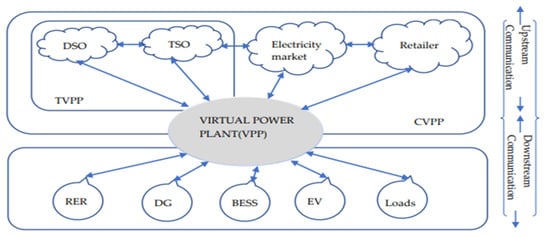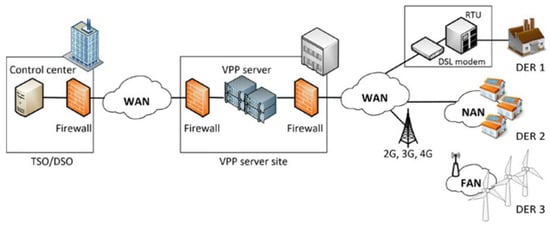You're using an outdated browser. Please upgrade to a modern browser for the best experience.
Please note this is an old version of this entry, which may differ significantly from the current revision.
Subjects:
Engineering, Electrical & Electronic
Virtual power plants (VPP) is a crucial component of the smart grid; this is made feasible by the network parts’ ability to coordinate themselves and the grid architecture’s ability to be controlled to its fullest potential.
- communication
- smart systems protection
- smart grid
1. Introduction
Sequel to the worsening energy crisis and rising environmental pollution, developing and utilizing renewable energy resources has become an unavoidable option for ensuring a secure and long-term energy supply. In recent years, installed capacities of renewable energy systems have increased, changing the power generation sources of power systems, which are dominated by fossil fuels to a high percentage of renewable energy sources [1]. As the modern intelligent grid/future electrical power systems rely substantially on the efficiency of the underlying communication infrastructure, traditional power distribution networks are rapidly transitioning to modern (smart) grids. The smart grid ecosystem is designed to enable high-demand real-time applications, such as electric vehicles, and balancing demand and supply in smart cities, and its general architecture includes distributed renewable energy sources (DRESs). As a result, in both industrialized and developing countries, there is a growing trend toward integrating DRESs into presently established energy networks. Nonetheless, integrating DRESs creates a highly scattered environment, which poses several issues in terms of real-time communication between smart grid operational layers and smart city applications [2] Power grid architecture and management are changing as a result of the incorporation of non-grid assets such as rooftop photovoltaics, microgeneration capabilities, battery storage, combined heat and power, electric vehicles, and other types of distributed energy resources in the distribution sphere [3]. The importance of renewable energy communication in the future grid (smart grid) cannot be overemphasized. Smart grid technology connects renewable energy sources to the electricity system and allows for efficient control and distribution. Utilities can use the Internet of Things (IoT) to collect data on the smart grid and use constant self-assessments to promptly remedy concerns. The smart grid and renewable energy have a relationship that revolves around data collection. These data are then rapidly delivered to the grid to alert the utility of any concerns, which enhances both service quality and safety [4].
Smart grids monitor, manage, and control electricity to fulfill the various requirements of their customers by utilizing artificial intelligence, digital technology, and cutting-edge communication strategies. Specifically, smart grids can coordinate the requirements and capacities of all market participants to ensure that every aspect of the system functions efficiently, reducing both financial and environmental costs while simultaneously maximizing the stability and dependability of the services offered [5,6].
2. The Concept of Virtual Power Plants in Renewable Energy Communication
New technologies and policies are needed to address both developing technical and economic difficulties as a result of the rapid upward penetration of DER and the continuing trend toward a more competitive electricity market. The concept of a virtual power plant (VPP) has emerged and is employed by many scientists to manage remote generation and increase its visibility inside electricity markets. Creating a “single virtual generating unit” that can function as a conventional one and can be seen or managed on an individual basis consists of integrating multiple tiny sized distributed generating units [16]. To function as a single power plant, a group of scattered generating units, controllable loads, and energy storage systems are combined to form a virtual power plant. Both fossil fuels and green energy sources are employed as generators. An energy management system, the brains of a VPP, controls the power flows coming from the generators, controllable loads, and storage. As a result of the communication being two-way, the VPP can transmit signals to control the objects as well as receive information about each unit’s present status.
The ideal VPP consists of three main parts: generation technology, energy storage technology, and information communication technology. The distributed generation technology can be classified into a domestic distributed generator, which is a small generating unit that serves individual consumers for residential, commercial, and industrial parts. Secondly, a publicly owned distributed generator does not belong to an individual consumer, and its main goal is to inject power production into the grid. Both can incorporate energy storage technology or operate without it. A very important requirement of VPPs is communication technologies and infrastructure, due to the inevitable two-way communication in its operations [17]. The VPP can be set up as a stand-alone or cloud-based installation as an information and communication technology (ICT) infrastructure to cut costs and assure security. Utilities, aggregators, retailers, and TSOs that own ICT infrastructure for daily operations typically dedicate their resources to VPP installations. However, smaller aggregators, merchants, and utilities with fewer ICT resources might benefit more from the introduction of cloud-based VPP [18].
In the downstream direction, the VPP communicates with a variety of geographically dispersed units, such as electric vehicles, flexible loads, distributed generation, battery energy storage systems, and renewable energy resources, allowing them to quickly respond and supply the necessary capacity for ancillary services. To integrate the VPP into the operation of the power system network, the VPP communicates independently with electricity retailers, aggregators, TSOs, DSOs, and the energy market in the upstream direction [19]. Figure 2 shows the VPPs concept. Both commercial (CVPP) and technical (TVPP) are possible VPPs. By placing bids on ancillary service marketplaces, CVPPs make it easier to trade DERs as a flexible resource in different energy markets, as opposed to TVPPs, which combine DERs from the same region for technical reasons and work to alleviate local grid constraints [20].

Figure 2. Concept of VPPs communication [20].
In conclusion, TCP is employed as a dependable transport protocol in the IP and Ethernet-based VPP communication system. Despite the stochastic nature of both IP and Ethernet, implementing a virtual private network often satisfies the quality of service and security requirements [21]. The architecture of the VPPs communication systems is depicted in Figure 3.

Figure 3. The architecture of VPPs communication system [21].
3. Virtual Power Plants for Smart Grid Operations
Inadequate coordination of the many communication networks used in various smart systems is a challenge for utilities. The integration of the power system, energy resources, and information technology is the cause of this lack of interoperability [22]. The network’s adoption of improved communication protocols and the penetration of distributed generators (DGs) make a grid smart. If DER and DG penetration is high and they are not adequately integrated, the main grid will have power losses and low power trading [23]. A decentralized method of energy dispatch is made possible by the proper coordination and aggregation control of DG units, which also enhances the distribution network and increases energy generation. This idea envisions “virtual power plants” (VPP). VPP is a crucial component of the smart grid; this is made feasible by the network parts’ ability to coordinate themselves and the grid architecture’s ability to be controlled to its fullest potential. Due to the utilization of certain smart grid DGs in VPP principles, there is less overlap between the two. For example, the desire for strong active power management on distribution networks for the best performance of the smart grid is immediately applied to VPP, delivering comparable solutions to the network’s issues. Because of this, different researchers have been able to define VPP from their perspectives. The authors in [24,25] state that VPP is a system that assembles numerous low- and medium-power DG units and energy storage devices by managing flexible loads on the grid to engage in power trading on the energy market or to offer backup energy services. The mechanism used to control DERs, flexible loads, energy storage devices, and the medium used for information exchange between the grid and energy users can also be used to define VPP [26]. The term VPP is used by the authors of [26] to describe a single power plant with an upgraded energy management system (EMS) that manages the operation of DERs, flexible loads, and energy storage devices. In contrast, the authors of [27] view VPP as an energy market with trading platforms for DERs that are bound by distance, capacity, size, and resource kinds.
After reviewing the numerous definitions, it is clear that the primary goal of VPP is to maximize the advantages of a smart grid by assuring correct information interchange between the supply and demand of energy [28]. The management approach suggested in [29] expands virtual power plants’ ability to provide first-rate energy services, enhance productivity, and enhance demand-side management. By permitting market participation, work has been performed on managing, planning, and controlling VPP. From low-voltage (LV) loads through medium-voltage (MV) substations to high-voltage (HV) virtual power plants, Cipcigan et al. designed an architectural concept for VPP with three aggregated echelons [30]. In contrast to the suggested architecture, multiple DG penetrations restrict voltage rise, thermal limitations at LV/MV substations, and transformer ratings [31].
This entry is adapted from the peer-reviewed paper 10.3390/en16010409
This entry is offline, you can click here to edit this entry!
